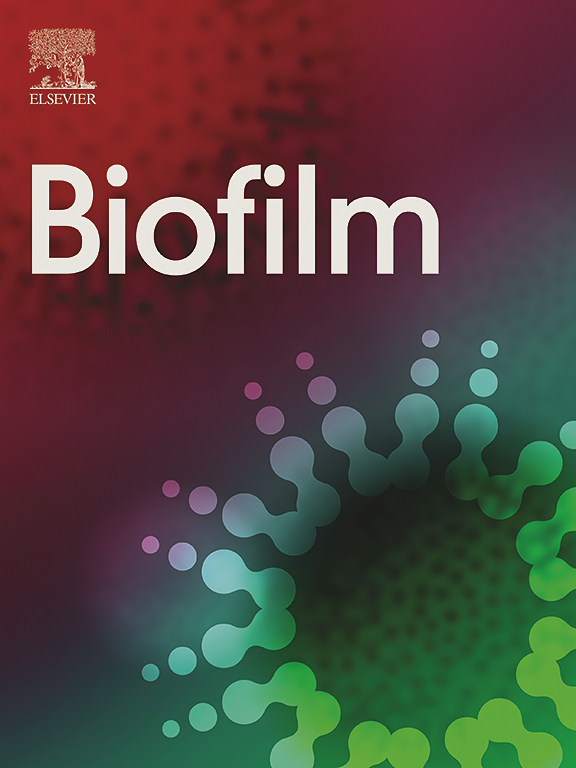Bacillus-derived lipopeptides inhibit and eradicate Candida tropicalis Biofilms: An in vitro exploration
IF 4.9
Q1 MICROBIOLOGY
引用次数: 0
Abstract
Candida tropicalis is a WHO-prioritised opportunistic fungal pathogen capable of causing superficial-to-systemic fungal infections and forming biofilms on both biotic and abiotic surfaces, such as tissues and medical implants. The rising incidence of fungal infections and the emergence of drug resistance underscore the urgent need for alternative, natural therapeutic agents such as antifungal macromolecules. AF4 and AF5, natural antifungal lipopeptide homologs derived from the Bacillus subtilis RLID strain, were purified to homogeneity from the cell free supernatant using semi-preparative scale HPLC with a C18 column at the final step. Using these lipopeptide fractions AF4 and AF5, the anti-biofilm efficacies were evaluated against C. tropicalis ATCC 750 biofilms and their synergistic potential with the standard antifungal fluconazole. Two compounds with amphiphilic nature were highly effective in preventing adhesion and inhibiting the formation of biofilm within 6 h. Additionally, they eradicated 24 h mature biofilms, as were demonstrated through various biofilm quantification techniques, including the crystal violet assay, XTT reduction assay, quantification of EPS, and ATR-FTIR analysis of biochemical composition of treated biofilms. In vitro studies revealed that AF4 and AF5 significantly reduced biofilm biomass and metabolic activity of cells embedded within the biofilm. Furthermore, morphological analysis of biofilms stained with Con A and FUN-1 using CLSM and COMSTAT analyses demonstrated a strong antibiofilm effect, including damaged cell surfaces and reduced hyphae structures, indicating effective biofilm disruption. Combinations of fluconazole with AF5 exhibited improved synergistic anti-biofilm effects. However, AF4 alone demonstrated strong potential to combat all phases of C. tropicalis biofilms.
芽孢杆菌来源的脂肽抑制和根除热带假丝酵母生物膜:体外探索
热带假丝酵母是世卫组织优先考虑的机会性真菌病原体,能够引起浅表至全身真菌感染,并在生物和非生物表面(如组织和医疗植入物)形成生物膜。真菌感染发病率的上升和耐药性的出现强调了对抗真菌大分子等替代天然治疗剂的迫切需要。AF4和AF5是枯草芽孢杆菌RLID菌株的天然抗真菌脂肽同源物,最后一步采用C18柱半制备级高效液相色谱从无细胞上清中纯化至均匀。利用这些脂肽组分AF4和AF5,评价了其对热带镰刀菌ATCC 750生物膜的抑菌效果及其与标准抗真菌药物氟康唑的协同作用潜力。两种具有两亲性的化合物在6小时内可以非常有效地防止粘附和抑制生物膜的形成。此外,通过各种生物膜定量技术,包括结晶紫测定、XTT还原测定、EPS定量和处理后生物膜生化成分的ATR-FTIR分析,可以证明它们可以根除24小时成熟的生物膜。体外研究表明,AF4和AF5显著降低了生物膜内细胞的生物量和代谢活性。此外,使用CLSM和COMSTAT分析对Con A和FUN-1染色的生物膜进行形态学分析,显示出强烈的抗生物膜作用,包括破坏细胞表面和减少菌丝结构,表明有效的生物膜破坏。氟康唑与AF5联合使用具有较好的协同抗生物膜作用。然而,AF4单独显示出强大的潜力,可以对抗热带梭菌生物膜的所有阶段。
本文章由计算机程序翻译,如有差异,请以英文原文为准。
求助全文
约1分钟内获得全文
求助全文

 求助内容:
求助内容: 应助结果提醒方式:
应助结果提醒方式:


